Industry Town: The Avant-Garde and Hollywood - repeat screening!
-
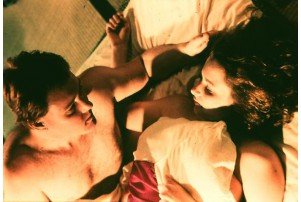 Based on Romance, by Bruce & Norman Yonemoto
Based on Romance, by Bruce & Norman Yonemoto
-
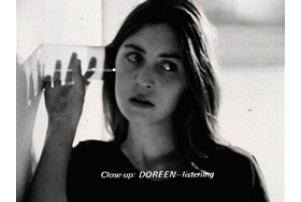 Title, by John Baldessari
Title, by John Baldessari
-
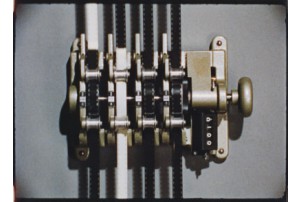 Cue Rolls, by Morgan Fisher
Cue Rolls, by Morgan Fisher
-
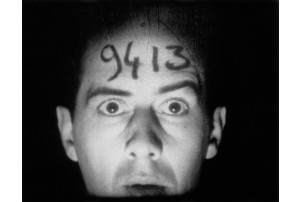 The Life and Death of 9413: A Hollywood Extra, by Robert Florey and Slavko Vorkapić
The Life and Death of 9413: A Hollywood Extra, by Robert Florey and Slavko Vorkapić
-
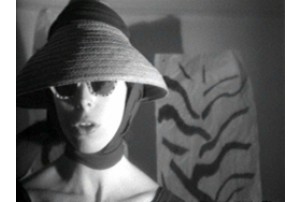 Zebra Skin Clutch, by Cynthia Maughan
Zebra Skin Clutch, by Cynthia Maughan
-
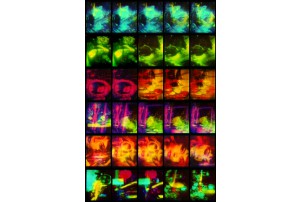 Death of the Gorilla, by Peter Mays
Death of the Gorilla, by Peter Mays
January 14, 2012, 5:00PM
Cinefamily, 611 N Fairfax Avenue, Los Angeles, 90036
**NOTE THE CHANGE IN DAY, TIME, AND LOCATION!**
Los Angeles Filmforum partners with Cinefamily to repeat the sold-out show Industry Town: The Avant-Garde and Hollywood as part of Alternative Projections: Experimental Film in Los Angeles, 1945-1980. Many experimental works have explicitly played with the dominant film industry (Hollywood and beyond), parodying its forms or structures of manufacture or utilizing images from classic and not-so-classic films as the raw material for new creations. We’ll start the show with one of the earliest examples of commentary on the Hollywood quest, and perhaps the first made with a expressionist bent in Los Angeles, Life and Death of 9413: A Hollywood Extra. Its importance is such that we have included it despite it coming from before 1945.
We continue through the decades with ever evolving approaches to the industry, practice and lifestyle of Hollywood. In Death of the Gorilla, Peter Mays manipulates footage filmed off late night television to create his own colorful collage of form and wonder. George Lucas’s 6-18-67 starts from the position of a standard movie “making of” short and subverts it into a meditation on landscape and beauty. By the time we reach the 1970s, the conceptual investigations of art of the time find appropriate parallels. John Baldessari’s Title breaks down some of the essential elements of screenplays, language, and acting. Zebra Skin Clutch (Cynthia Maughan, 1977-78) looks at a woman and her relationship to the fabulous styles of starlets, revealing the influence of celebrity and fashion (for a lovely comparison, check out Kenneth Anger’s Puce Moment at MOCA). Based on Romance utilizes storytelling traditions of melodrama but locates the scenes in the art world of the time.
In person: Morgan Fisher, Peter Mays, more to be announced
Tickets: General $10, Students/seniors $6; free for Filmforum members
Advance ticket purchase available through Brown Paper Tickets
Films to be Screened
-
 The Life and Death of 9413: A Hollywood Extra, by Robert Florey and Slavko Vorkapić
The Life and Death of 9413: A Hollywood Extra, by Robert Florey and Slavko Vorkapić
The Life and Death of 9413: A Hollywood Extra (1928, 16mm (orig. 35mm), b/w, silent, 11min.)
Directed by Robert Florey and Slavko VorkapichPrint courtesy of the Academy Film Archive
Its makers all went on to become influential figures in different ways, Toland as the cinematographer of Citizen Kane and other films, Florey as director; and Vorkapich as the conceptual master of film form, teaching at USC for many years.
Article on it: http://forgottenclassicsofyesteryear.blogspot.com/2010/07/life-and-death-of-9413-hollywood-extra.html
-
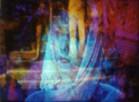 Death of the Gorilla, by Peter Mays
Death of the Gorilla, by Peter Mays
The Death of the Gorilla (1966, 16mm, color, sound, 16min.)
Directed by Peter MaysRestored print from the Academy Film Archive
“Peter Mays achieved these hypnotically dense and hallucinatory in-camera superimpositions by shooting off late-night TV with color filters in multiple passes, then edited the mass of footage into a psychedelic phantasmagoria suggesting an elusive, dream-like narrative.”—Mark Toscano
-
6-18-67 (1967, digital (orig. 16mm), color, sound, 5min.)
Directed by George LucasA behind-the-scenes documentary about the making of the film MacKenna's Gold (1969)
-
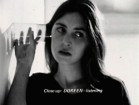 Title, by John Baldessari
Title, by John Baldessari
Title (1971, 16mm, b/w & color, sound, 20 min.)
Directed by John BaldessariBaldessari progresses from simple, static images, such as a rock in an empty room, to complex narrative scenes, like a woman eavesdropping on her next-door neighbor. Through the gradual integration of cinematic techniques—motion, color, sound, acting, editing and arc—the artist inverts the traditional Hollywood model, stressing structure over narrative coherence. – Electronic Arts Intermix
-
 Metro-Goldwyn-Mayer by Jack Goldstein
Metro-Goldwyn-Mayer by Jack Goldstein
Metro-Goldwyn-Mayer (1975, 16mm, color, sound, 2 min.)
Directed by Jack GoldsteinPrint courtesy of Galerie Buchholz, Koln, and MOCA
“Goldstein's iconic two-minute tour de force, brings media's subliminal power to the fore," - Jordan Kantor, Artforum review
“The film represents a short performance sequence that signifies the power of MGM as the penultimate studio—in fact, as the very model for the Golden Era of Hollywood studios, which even already in 1975 belonged to a distant “then” of the past. “Going to the movies” represents a staged sequence of ordered entrances into the apparatus of cinema. “ - Fareed Armaly , from longer article on the film: http://www.constanzeruhm.net/portfolio/jack-goldstein-metro-goldwyn-mayer.phtml
-
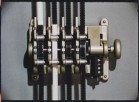 Cue Rolls, by Morgan FIsher
Cue Rolls, by Morgan FIsher
Cue Rolls (1974, 16mm, color, sound, 5.5min.)
Directed by Morgan Fisher“As the soundtrack makes clear, Fisher has applied what once was a standard industry practice (for making colour corrections and other modifications before final prints were struck) to a situation in which it would seem to be entirely irrelevant. Specifically, a single continuous forty-foot shot of four strips of leader moving through the synchronizer was “analysed” into ten-foot segments that were subsequently A and B rolled so that the ten-foot segments could be re-synthesized into a convincing illusion of the original, uncut shot. The leader moving through the synchronizer was a plan for the negative cutter who would edit (or who, by the time we see the film, has edited) Cue Rolls.” – Scott MacDonald -
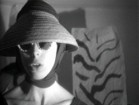 Zebra Skin Clutch, by Cynthia Maughan
Zebra Skin Clutch, by Cynthia Maughan
Zebra Skin Clutch (1977-78, video, b/w, sound, 2:03)
Directed by Cynthia MaughanVideo from Electronic Arts Intermix
-
 Based on Romance, by Bruce and Norman Yonemoto
Based on Romance, by Bruce and Norman Yonemoto
Based on Romance (1979, video, color, sound, 24:15)
Directed by Norman Yonemoto and Bruce YonemotoThis stylized narrative is the first in the Yonemotos' Soap Opera Series,in which they employ the traditional syntax and codes of melodrama to explore how mass media formulas manipulate desire and sexuality, fantasy and reality. Played out with the self-conscious acting and dialogue of a soap opera, this story of the dissolution of a contemporary romance is set in the context of the postmodern Southern California art scene. By emphasizing modes of representation — TV, movies, art — the Yonemotos reconstruct a narrative of melodrama itself, illustrating their assertion that personal dramas and romantic ideals are the result of media propaganda, a social fantasy that becomes reality.